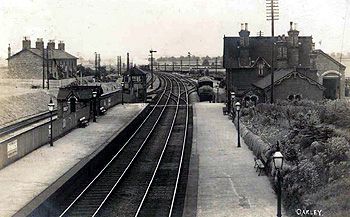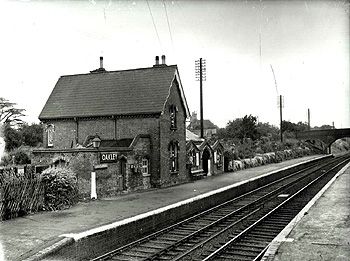
Oakley Station was built in 1856 and 1857 by the Midland Railway Company. It was part of a new line the company built between Wigston in Leicestershire and Hitchin [Hertfordshire]. It then went on to London but for the latter part of the journey ran over the tracks of the Great Northern Railway Company into King’s Cross Station. The engineer was Charles Liddell and the contractor Thomas Brassey. The authority for the building the railway line came from an act of parliament of 1855. The railway is said to have cost about £19,000 per mile and was expensive in places to construct: between Bedford and Sharnbrook, including in the parish of Oakley, the River Great Ouse had to be crossed seven times, for example.
In his book The Railway Age in Bedfordshire the late Fred Cockman quotes the initial attitude of the Duke of Bedford to the possibility of a railway line running through Oakley and, thus, close to his hunting lodge of Oakley House. His steward wrote on 22nd January 1847: “The Duke signed his Assent to the Luton & Dunstable Railway and to the Cambridge & Bedford by Biggleswade, but to the Leicester, Bedford and Hitchin his Grace does not feel disposed to assent, on account of Oakley, although he by no means wishes to oppose the scheme … [but] no amount of money can compensate him for what he may consider an intrusion on the privacy of his Residence”. Two days later, however, the Duke had changed his mind: “I do not think the Midland Company would wish to make a station at Oakley, but I think when the Duke may be staying there, he will not like to go to Bedford … It would be always a convenience to have Fish, or parcels left in passing by. If, therefore, it is of sufficient consequence, now is the time to mention it … get an interview with Hudson – as I dare say we can to nothing in it without the full concurrence of His Majesty”. In the event, as noted above, nothing transpired for another decade but one presumes that the Duke’s attitude had not significantly changed.

The line formally opened to passengers on 8th May 1857. In 1867 it took between eight and fourteen minutes to travel between Oakley and Bedford , the journey taking longer at weekends. The following year the line was reduced from a main line to a branch line when the Midland Railway Company opened a direct route to London into its new terminus at Saint Pancras.
The passenger buildings along the line, including at Oakley, were built of yellow brick and tended to be small, with lattice windows set in a cast iron frame. The former goods shed and coal offices at Oakley Station were listed by the former Department of Environment in August 1987 as Grade II, of special interest. The goods shed is built of red brick, unlike the passenger buildings, with polychrome brick dressings and slate roofs with modillion brick eaves. It is a one storey construction with two full height archways with polychrome heads. There are two outer arched recesses with gauged brick heads and one central one, each containing semi-circular headed metal casements. The former coal offices are also in red brick with polychrome red and yellow brick dressings and a Welsh slate roof. Again they are one storey and have modillion brick eaves. Alternating from left to right are three four panel doors with arched heads and three pairs of fixed light windows with geometric tracery and arched heads.
Following the reduction to branch line status the numbers of passengers using the line which stopped at Oakley fell dramatically. The Midland Railway Company ceased to exist in 1921 when the Railways Act grouped companies together. The Midland joined the London North Western Railway Company, the Lancashire and Yorkshire Railway Company, the Caledonian Railway Company and the Glasgow and South Western Railway Company to form the London Midland Scottish Railway. The Transport Act 1947 abolished this company which became part of British Railways. Oakley Station closed in 1958, unable to justify its existence economically with the advent of widespread motor traffic.
Directories for Bedfordshire, which were not published annually but every few years, give the names of station masters from 1869 until 1924 and the following names are taken from these directories. The dates are the dates the name first and last appears not the dates of appointment and resignation.
- Walter Moore: 1869-1877;
- George Aldred: 1885-1890;
- George Best: 1894;
- George Hunt: 1898-1903;
- Frank Sugars: 1906;
- Edward Arnold: 1910;
- Walter Slater: 1914-1920;
- George Turner: 1924.

